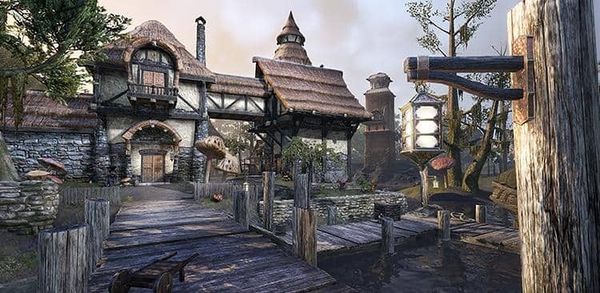General:ESO: Morrowind – Building Upon the Past
Originally published May 15, 2017. The original article can be found here.

Vvardenfell for New and Old[edit]
When recreating the Dark Elves' ancestral home, great care was taken to emulate Bethesda Game Studio's 15-year-old classic, making it the perfect jumping on point for TES III veterans who are interested in The Elder Scrolls Online.
"We want the TES III players to feel like they're coming back home," says the game's Creative Director, Rich Lambert. "So we spent a lot of time recreating all the locations that they know from TES III in ESO: Morrowind."
The best example of this can be found in the very first location you will visit when you arrive in Vvardenfell: Seyda Neen. The starting location in TES III is also the first place you visit after the tutorial in ESO: Morrowind, and the port town's wooden docks and Census and Excise Office should seem very familiar to you if you played the original game.
When building Vvardenfell in ESO: Morrowind, it was important to the team to faithfully recreate and build upon all of TES III's most iconic locations. If you are an Elder Scrolls veteran, you'll be able to once more experience Vivec City, Sadrith Mora, the Great Houses, the Ordinators, Silt Striders, and everything else that makes the game's unique setting so special.
"There are Elder Scrolls players who haven't yet had a chance to play The Elder Scrolls Online, and so with ESO: Morrowind, we really wanted to pique their interest," says Lambert. "We wanted to show them that they can go back to Vvardenfell and experience something new but also familiar."
Building An Old World[edit]
Crafting the Dark Elf homeland comes with its own unique challenges, but it begins and ends with TES III.
"When building Vvardenfell in ESO:Morrowind, we started with TES III," says ESO's Art Director, Jared Carr. "We grabbed the height map directly from the original game and used that as a starting point for building the terrain, and we referenced TES III's key architecture styles for the structures."
By using the original game's height map, the team was able to place each location exactly where it should be and ensured that the island's topography was recreated faithfully.
It's not just the size and shape of the island itself that'll seem familiar. As you venture from coast to coast, you will recognize the stylings of House Hlaalu, House Redoran, and House Telvanni from the original game. Even locations such as the ancestral tombs will be instantly recognizable to Elder Scrolls players.
"The whole goal is to take the original game and world and re-envision it so that it's more detailed."
Of course, when building Vvardenfell, the team also looked outside of the game for reference material, and when designing furnishings and the smaller, more intimate items, the team looked to real-world influences to build out the world and Dunmer culture.
"Everything we do in ESO is a combination of an established aesthetic that draws influence from the real world," says Carr. "It's what makes the Elder Scrolls believable."
Unique Stories in the Familiar[edit]
ESO: Morrowind is set 700 years before the events of TES III, and a lot has changed in that time. Most notably, with Dagoth Ur and the Ash Storms yet to come, the island's flora and fauna is very different, giving the development team an opportunity to create new experiences and give some classic areas a new look.
The best example might be found in Balmora. In ESO: Morrowind, you will notice that while the iconic city still has the familiar buildings and bridges, it is also surrounded by trees and dense vegetation. Not at all like the dusty township of the original game.
In addition to this, the development team has the tech to add even more elements to the world than was previously possible. This means that while there is a strong connection to the original game, the team had the space and the tools to fill out the world.
"With ESO: Morrowind, we were able to add a lot of additional detail," says Carr. "It's 15 years later in development time, and with our game engine we can get more into the world than ever."
You can see this in the intricacies of the murals in Vivec's Palace and Cantons of Vivec City or in the level of detail in the monsters that roam Vvardenfell's tombs and wilderness.
The game's setting in the Second Era also allows the team to develop unique aspects of the series' lore, creating opportunities for the team to tell brand new stories. For example, in ESO: Morrowind, you will have the opportunity to see and learn about the Telvanni mushroom towers and how they came to be - something that hasn't yet been explored in Elder Scrolls lore.
Return to Morrowind[edit]
Are you a veteran Elder Scrolls player returning to Morrowind after 15 years? Or is this the first time you'll ever experience the home of the Dark Elves? We'd love to hear about which parts of the island you plan to visit first on Twitter @TESOnline and on Facebook.
You can read more about ESO: Morrowind here.


